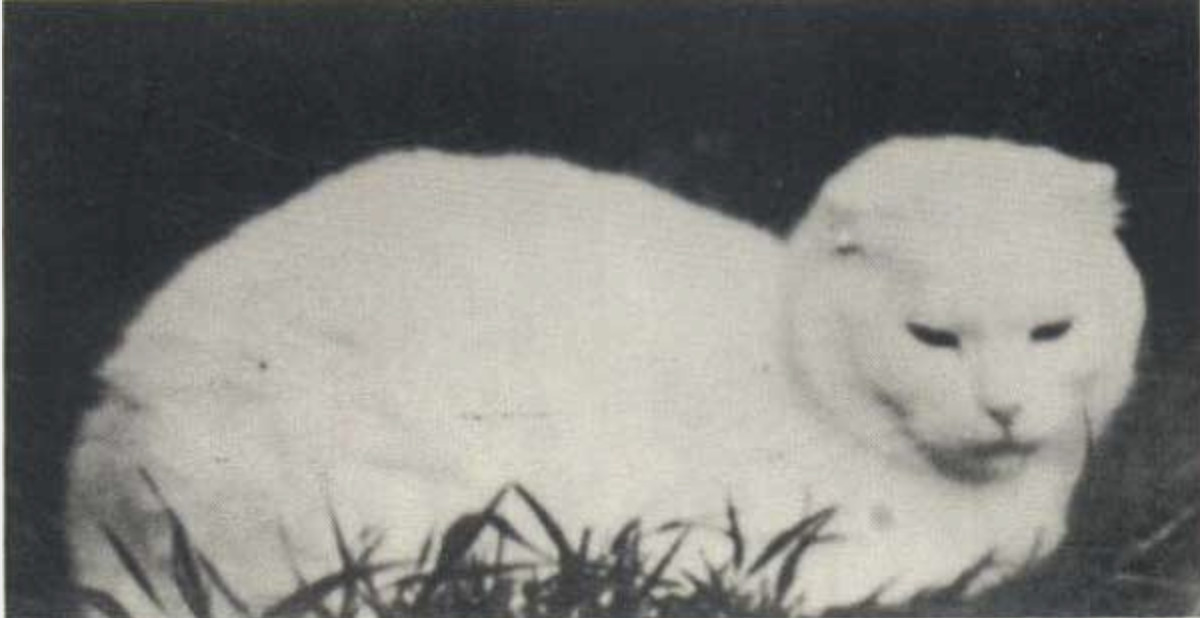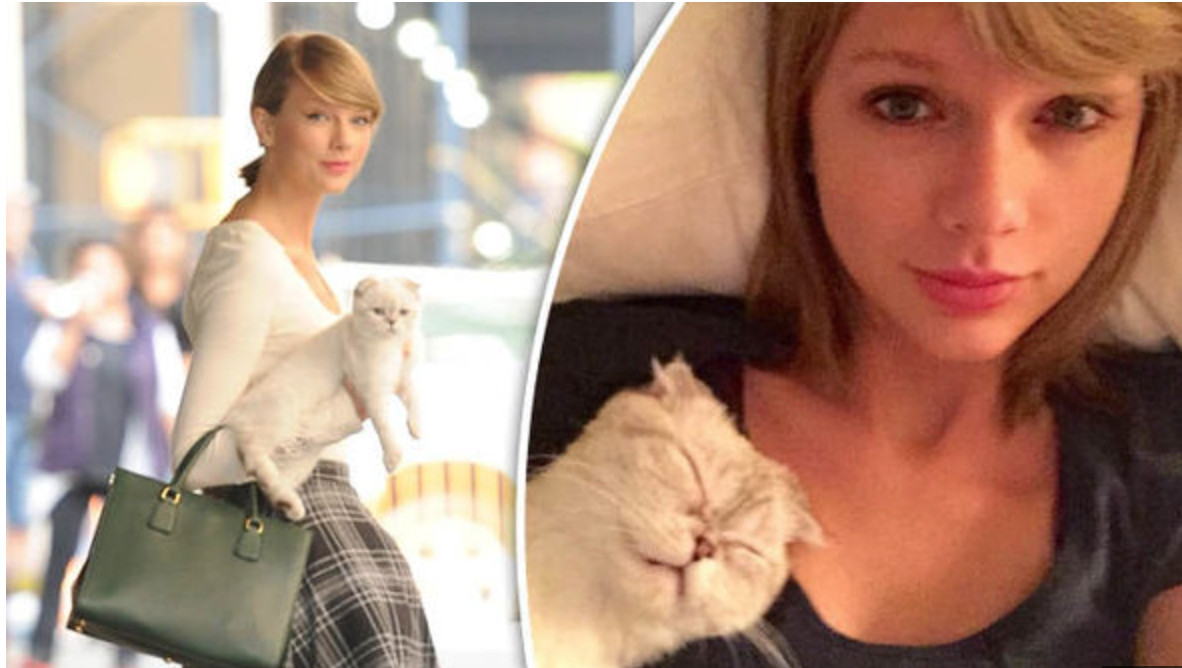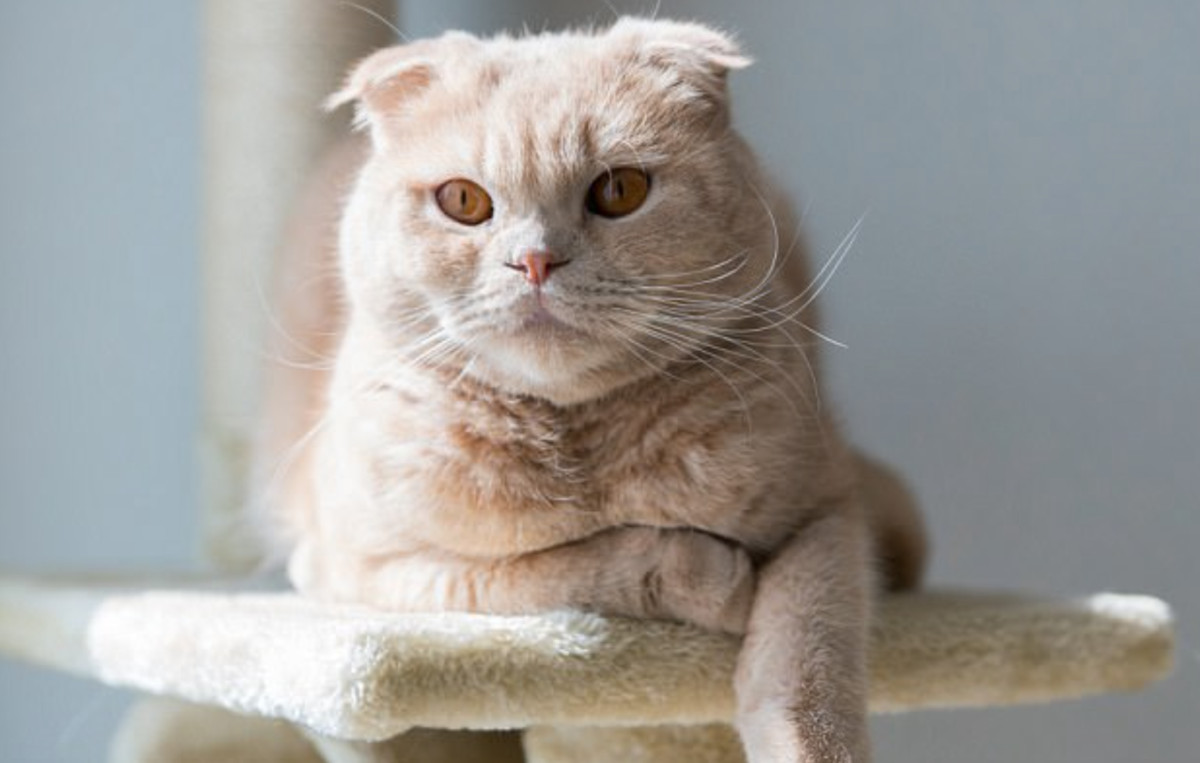The Scottish Fold cat, instantly recognizable by its charming folded ears, is a breed that captures hearts with its unique appearance and gentle nature. These cats are undeniably cute, often likened to owls or teddy bears thanks to their distinctive ear shape and rounded features. While their endearing looks have propelled them to popularity, particularly on social media and as pets of celebrities, it’s important to delve deeper than just their appearance. This article explores everything you need to know about the Scottish Fold cat breed, from their fascinating history and physical characteristics to their temperament, care needs, and the serious health concerns surrounding their unique folded ears.
 Susie, the original Scottish fold cat
Susie, the original Scottish fold cat
Tracing the Origins: The History of the Scottish Fold
The story of the Scottish Fold cat begins in 1961 on a farm near Coupar Angus in the Tayside region of Scotland. It was here that a shepherd named William Ross noticed an unusual white barn cat named Susie. Susie stood out from all the other farm cats because of her distinctly folded ears, a feature never before seen. Little did Ross know, this single cat would become the matriarch of an entire breed.
Intrigued by Susie’s unique appearance, William Ross acquired one of her kittens when she had a litter. This kitten, a white female named Snooks, inherited her mother’s folded ears. Recognizing the potential for a new and distinctive cat breed, Ross, with the help of cat geneticist Pat Turner, embarked on establishing what would become known as the Scottish Fold.
Susie’s folded ears were the result of a natural genetic mutation. This mutation affects cartilage throughout the body, but it is most visibly expressed in the ears, causing them to fold forward and downward towards the head. Genetic studies later confirmed that this ear fold trait is caused by a dominant gene. In the early breeding programs, approximately half of the kittens born to a Scottish Fold parent inherited the folded ear trait.
In 1966, William Ross officially registered the Scottish Fold breed with the Governing Council of the Cat Fancy in the UK. Initially, they were sometimes referred to as “lop-eared cats,” but the name was soon changed to the more geographically descriptive “Scottish Fold.” Sadly, Susie, the foundational cat of the breed, met an untimely end just three months after her first litter when she was hit by a car. Despite her short life, her legacy lives on, as every Scottish Fold cat today can trace its lineage back to Susie.
 Scottish Fold cat with distinctive folded ears, looking directly at the camera
Scottish Fold cat with distinctive folded ears, looking directly at the camera
While Susie is considered the modern origin, historical accounts from 1796 mention folded-ear cats in China in the Universal Magazine of Knowledge and Pleasure. Whether there’s a connection between these ancient Chinese cats and the Scottish Fold is debated, but Susie remains the documented starting point for the breed as we know it today.
Recognizing a Scottish Fold: Key Physical Traits
Beyond their signature folded ears, Scottish Fold cats possess a suite of physical characteristics that contribute to their appealing appearance. They are medium-sized cats known for their rounded features. This roundness is evident in their face, body, and even their large, wide-set eyes, giving them a perpetually sweet and innocent expression.
The Unmistakable Ears
The hallmark of the Scottish Fold cat is, of course, their folded ears. Interestingly, Scottish Fold kittens are born with straight ears. The folding process begins to occur when they are between 18 and 24 days old, and even then, not all kittens in a litter will develop folded ears. Those that do can exhibit varying degrees of folding:
- Single Fold: Only the tip of the ear folds forward.
- Double Fold: Half of the ear folds down.
- Triple Fold: The entire ear lies flat against the head.
For showing purposes, a triple fold is generally considered the ideal standard in regions where the breed is accepted for competition. Despite their folded shape, Scottish Fold cats retain full mobility and expressiveness in their ears. They can still swivel their ears to pinpoint sounds, flatten them when annoyed, and perk them up when curious or excited, especially when treats are involved!
 Close-up of a Scottish Fold cat's folded ears, showcasing the unique shape
Close-up of a Scottish Fold cat's folded ears, showcasing the unique shape
Body and Coat
Scottish Folds are medium-sized cats with a rounded body conformation. They have a stocky build, a short neck, and a short nose, all contributing to their cuddly appearance. They often appear “padded” around the middle, further enhancing their soft and approachable look.
Their coats come in both short and long-haired varieties. Short-haired Scottish Folds have a dense, plush coat that is surprisingly thick and resilient. The long-haired version is known as the Highland Fold. Highland Folds boast a semi-long to long coat with feathering on the tail, ears, and paws, and a prominent ruff around their neck, though the hair on their face tends to be shorter.
Thanks to crossbreeding with British and American Shorthairs to improve genetic diversity and reduce health issues, Scottish Folds can be found in a wide array of coat colors and patterns. However, certain colorations like Siamese points, chocolate, and lilac are often disqualifications in cat shows, particularly in the United States.
It’s important to note that Scottish Folds are not hypoallergenic. Individuals with cat allergies may still experience allergic reactions to this breed.
Scottish Fold vs. British Shorthair
Scottish Folds and British Shorthairs share some visual similarities, particularly in their rounded faces and stocky builds, which is due to their shared breeding history. However, distinct differences set them apart. Besides the obvious folded ears of the Scottish Fold, British Shorthairs tend to be larger and heavier cats. British Shorthairs always have short, dense coats, while Scottish Folds can have either short or long hair. In terms of personality, Scottish Folds are often described as more affectionate and people-oriented, while British Shorthairs can be more independent.
The Temperament of a Scottish Fold: Gentle and Affectionate
Scottish Fold cats are renowned for their sweet and gentle temperaments. They are known to be very friendly, loving, and enjoy human companionship. These cats thrive on attention and often develop strong bonds with their families, sometimes even following their favorite people from room to room. However, this desire for companionship means they can become lonely or even destructive if left alone for extended periods.
While not excessively vocal compared to some breeds, Scottish Folds are not silent cats. They are known to produce a variety of soft, chirping meows and purrs to communicate their needs and desires. They are intelligent and curious cats who enjoy playing and exploring. Despite their somewhat laid-back nature, they are also surprisingly agile and enjoy climbing to high vantage points.
Interestingly, Scottish Folds are often observed to bond most strongly with one particular person in the household, similar to how dogs often choose a “favorite” human. This doesn’t mean they won’t be affectionate with other family members, but their primary loyalty and attachment may be clearly directed towards one individual.
Deciphering Scottish Fold Emotions
Understanding your Scottish Fold’s emotions is relatively straightforward, as they express themselves through typical feline body language. Like other cats, slow blinks and half-closed eyes indicate contentment and relaxation. Wide eyes with dilated pupils can signal excitement or playfulness, but also potentially fear or aggression depending on the context. Narrowed eyes often suggest displeasure or irritation.
Kneading, where they gently push their paws into you with retracted claws, is a common sign of affection and comfort in Scottish Folds. A swishing or wagging tail in a cat, unlike in dogs, usually indicates agitation or unhappiness. An arched back can also be a sign of fear or aggression. Paying attention to these subtle cues in your Scottish Fold’s body language will help you understand their mood and respond appropriately.
 Scottish Fold cat sitting upright in the "Buddha position"
Scottish Fold cat sitting upright in the "Buddha position"
Scottish Folds are also known for exhibiting some quirky habits. They are sometimes seen sitting upright in a “Buddha-like” position with their legs extended and paws resting on their belly. They may also sleep on their backs in unusual postures. These endearing quirks add to their charm and make them even more captivating companions.
Caring for Your Scottish Fold: Grooming and Nutrition
Grooming needs for a Scottish Fold depend on their coat length. Short-haired varieties require weekly brushing to remove loose hair and maintain coat shine. Highland Folds, with their longer coats, need more frequent grooming, ideally two to three times a week, to prevent mats and tangles.
Regular nail trimming is essential for all Scottish Folds, typically on a weekly basis, though this may vary depending on their activity level and whether they have access to scratching posts or the outdoors. Dental hygiene is also important. Regular teeth brushing with pet-safe toothpaste is recommended to promote good oral health and fresh breath.
Due to their folded ears, Scottish Folds require regular ear cleaning. Weekly ear checks are necessary to monitor for wax buildup, dirt, or signs of infection. Gentle cleaning with a vet-approved ear cleaner is recommended as needed.
Nutrition plays a crucial role in the health of a Scottish Fold. They thrive on a diet rich in protein and low in carbohydrates. This dietary approach helps support their joint health and manage their weight, as they can be prone to becoming overweight, especially given their tendency towards a somewhat sedentary lifestyle. A high-quality cat food that prioritizes meat-based protein sources is ideal.
Scottish Fold Health Concerns: The Shadow of Osteochondrodysplasia
The very gene that gives Scottish Fold cats their adorable folded ears, unfortunately, also predisposes them to serious health problems. The genetic mutation responsible for the ear fold affects cartilage formation throughout the body, leading to a condition called osteochondrodysplasia. This is a degenerative joint disease that can cause significant pain and mobility issues.
Osteochondrodysplasia in Scottish Folds can manifest in various ways, but it commonly affects the limbs, tail, and joints. Symptoms can range from mild stiffness to severe lameness, pain, and arthritis. The severity of the condition can vary, but it is a progressive and incurable disease.
The ethical implications of breeding Scottish Fold cats are significant due to this inherent health issue. Veterinary organizations and animal welfare advocates have raised concerns about the welfare of these cats, arguing that breeding them perpetuates suffering. The Governing Council of the Cat Fancy in the UK stopped registering Scottish Folds in the 1970s due to these health concerns.
 Scottish Fold cat looking concerned, highlighting potential health issues
Scottish Fold cat looking concerned, highlighting potential health issues
While some breeders claim that outcrossing Scottish Folds with straight-eared breeds like British or American Shorthairs reduces the risk of osteochondrodysplasia, veterinary experts argue that all Scottish Folds with folded ears carry the gene and will develop some degree of the disease, although the severity and onset may vary.
The Ethical Debate: Should Scottish Fold Breeding Be Banned?
The question of whether Scottish Fold breeding should be banned is a subject of ongoing debate and ethical consideration. Animal welfare organizations and veterinary professionals often advocate against breeding Scottish Folds due to the high likelihood of them developing osteochondrodysplasia and experiencing chronic pain. They argue that prioritizing the breed’s unique appearance over its well-being is unethical.
Gudrun Ravetz, former president of the British Veterinary Association, has stated that breeding Scottish Folds is an example of prioritizing aesthetics over animal welfare. She emphasizes that all Scottish Folds with folded ears will develop osteochondrodysplasia to some degree, leading to lifelong pain and suffering.
Conversely, some breeders and breed enthusiasts argue for responsible breeding practices, claiming that outcrossing and careful selection can minimize health problems. However, the fundamental genetic flaw remains, and there is no way to eliminate the risk of osteochondrodysplasia in Scottish Folds entirely as long as folded ears are the defining breed trait.
Currently, there is no breeding ban on Scottish Folds in the UK or many other parts of the world, but the ethical concerns persist. Some organizations are reviewing their policies regarding the promotion of the breed, reflecting the growing awareness of the welfare issues associated with Scottish Fold cats.
Conclusion: A Loving Companion, But Consider the Health Realities
Scottish Fold cats are undeniably charming and make wonderful companions for those prepared to offer them love, attention, and proper care. Their gentle personalities and affectionate nature endear them to many cat lovers. However, it is crucial to be fully aware of the significant health challenges associated with this breed, particularly osteochondrodysplasia.
If you are considering a Scottish Fold cat, it is imperative to understand the potential for chronic pain and mobility issues they may face. Adopting an older Scottish Fold from a rescue organization might be a more ethical choice than purchasing a kitten, as you would be providing a home for a cat already in need. Thorough research, careful consideration of the ethical implications, and a commitment to providing lifelong veterinary care are essential before bringing a Scottish Fold cat into your life. While their cuteness is undeniable, prioritizing their health and well-being must be paramount.
